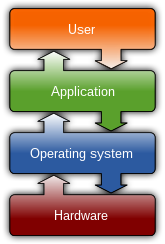This article includes a list of general references, but it lacks sufficient corresponding inline citations. (October 2009) |
| Operating systems |
|---|
 |
| Common features |
A virtual file system (VFS) or virtual filesystem switch is an abstract layer on top of a more concrete file system. The purpose of a VFS is to allow client applications to access different types of concrete file systems in a uniform way. A VFS can, for example, be used to access local and network storage devices transparently without the client application noticing the difference. It can be used to bridge the differences in Windows, classic Mac OS/macOS and Unix filesystems, so that applications can access files on local file systems of those types without having to know what type of file system they are accessing.
A VFS specifies an interface (or a "contract") between the kernel and a concrete file system. Therefore, it is easy to add support for new file system types to the kernel simply by fulfilling the contract. The terms of the contract might change incompatibly from release to release, which would require that concrete file system support be recompiled, and possibly modified before recompilation, to allow it to work with a new release of the operating system; or the supplier of the operating system might make only backward-compatible changes to the contract, so that concrete file system support built for a given release of the operating system would work with future versions of the operating system.